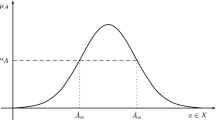Abstract
Most computer systems that deal with issues of space reason about distance by using a metric. For example, most geographic information systems apply the euclidean metric, requiring all subjects to adhere to the same view of space. As a result, dealing with imprecise or uncertain geographic information becomes difficult or sometimes even impossible. In this paper, we describe a way of reasoning about distance that is not restricted to euclidean geometry. The idea is to use fuzzy sets to describe how close objects are to each other.
Similar content being viewed by others
References
J. Coppock and D. Rhind, “The history of GIS,” in Geographical Information Systems: Principles and Applications, edited by D. Maguire, M. Goodchild, and D. Rhind, Longman Scientific & Technical: Essex, England, pp. 21–43, 1991.
E. Clementini, P. Di Felice, and D. Hernández, “Qualitative representation of positional information,” Artificial Intelligence, vol. 95(2), pp. 317–356, 1997.
H. Guesgen and J. Albrecht, “Imprecise reasoning in geographic information systems,” Fuzzy Sets and Systems (Special Issue on Uncertainty Management in Spatial Data and GIS), vol. 113, no. 1, pp. 121–131, 2000.
C. Freksa, “Qualitative spatial reasoning,” in Proc. Workshop RAUM, Koblenz, Germany, 1990, pp. 21–36.
D. Hernández, “Relative representation of spatial knowledge: The 2-D case,” in Cognitive and Linguistic Aspects of Geographic Space, edited by D. Mark and A. Frank, Kluwer: Dordrecht, The Netherlands, pp. 373–385, 1991.
A. Mukerjee and G. Joe, “A qualitative model for space,” in Proc. AAAI-90, Boston, Massachusetts, 1990, pp. 721–727.
D. Dubois, H. Fargier, and H. Prade, “Propagation et satisfaction de constraintes flexibles,” in Fuzzy Sets, Neural Networks and Soft Computing, edited by R. Yager and L. Zadeh, Kluwer: Dordrecht, The Netherlands, 1993.
H. Fargier, J. Lang, and T. Schiex, “Selecting preferred solutions in fuzzy constraint satisfaction problems,” in Proc. 1st European Congress on Fuzzy and Intelligent Technologies, Aachen, Germany, 1993.
H. Guesgen, “Some techniques for solving fuzzy CSPs,” in Proc. Australasian Workshop on Constraint Programming and Applications (CPA-99), Sydney, Australia, 1999, pp. 1–10.
H. Guesgen and A. Philpott, “Heuristics for solving fuzzy constraint satisfaction problems,” in Proc. ANNES-95, Dunedin, New Zealand, 1995, pp. 132–135.
I. Bloch, “Spatial representation of spatial relationship knowledge,” in Proc. KR-00, Breckenridge: Colorado, 2000, pp. 247–258.
H. Guesgen and J. Hertzberg, “Spatial persistence,” Applied Intelligence (Special Issue on Spatial and Temporal Reasoning), vol. 6, pp. 11–28, 1996.
H. Guesgen and J. Hertzberg, “Buffering in fuzzy geographic information systems,” in Proc. International Conference on Geographic Information Science (GIScience-00), Savannah, Georgia, 2000, pp. 189–192.
M. Gahegan, “Proximity operators for qualitative spatial reasoning,” in Spatial Information Theory: A Theoretical Basis for GIS, edited by A. Frank and W. Kuhn, Lecture Notes in Computer Science, vol. 988, Springer-Verlag: Berlin, 1995.
H. Guesgen and D. Poon, “Computing proximity in geographic information systems,” in Proc. IJCAI-97 Workshop on Spatial and Temporal Reasoning, Nagoya, Japan, 1997, pp. 55–60.
H. Samet, The Design and Analysis of Spatial Data Structures, Addison-Wesley: Reading, MA, 1990.
M. Worboys, “Metrics and topologies for geographic space,” in Proc. SDH-96, Delft, The Netherlands, 1996, pp. 7A.1–11.
L. Zadeh, “Fuzzy sets,” Information and Control, vol. 8, pp. 338-353.
Author information
Authors and Affiliations
Rights and permissions
About this article
Cite this article
Guesgen, H.W. Reasoning About Distance Based on Fuzzy Sets. Applied Intelligence 17, 265–270 (2002). https://doi.org/10.1023/A:1020087332413
Issue Date:
DOI: https://doi.org/10.1023/A:1020087332413




